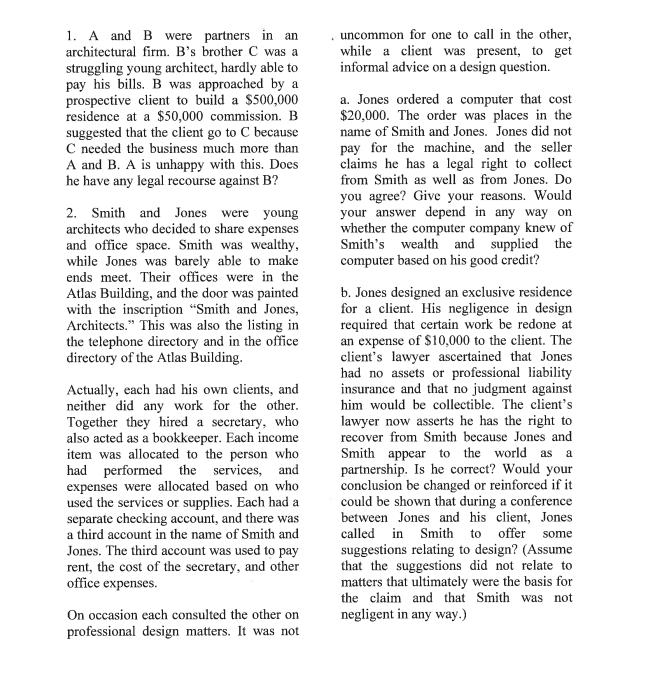Answered step by step
Verified Expert Solution
Question
1 Approved Answer
1. A and B were partners in an architectural firm. B's brother C was a struggling young architect, hardly able to pay his bills.

1. A and B were partners in an architectural firm. B's brother C was a struggling young architect, hardly able to pay his bills. B was approached by a prospective client to build a $500,000 residence at a $50,000 commission. B suggested that the client go to C because C needed the business much more than A and B. A is unhappy with this. Does he have any legal recourse against B? 2. Smith and Jones were young architects who decided to share expenses and office space. Smith was wealthy, while Jones was barely able to make ends meet. Their offices were in the Atlas Building, and the door was painted with the inscription "Smith and Jones, Architects." This was also the listing in the telephone directory and in the office directory of the Atlas Building. Actually, each had his own clients, and neither did any work for the other. Together they hired a secretary, who also acted as a bookkeeper. Each income item was allocated to the person who had performed the services, and expenses were allocated based on who used the services or supplies. Each had a separate checking account, and there was a third account in the name of Smith and Jones. The third account was used to pay rent, the cost of the secretary, and other office expenses. On occasion each consulted the other on professional design matters. It was not uncommon for one to call in the other, while a client was present, to get informal advice on a design question. a. Jones ordered a computer that cost $20,000. The order was places in the name of Smith and Jones. Jones did not pay for the machine, and the seller claims he has a legal right to collect from Smith as well as from Jones. Do you agree? Give your reasons. Would your answer depend in any way on whether the computer company knew of Smith's wealth and supplied the computer based on his good credit? b. Jones designed an exclusive residence for a client. His negligence in design required that certain work be redone at an expense of $10,000 to the client. The client's lawyer ascertained that Jones had no assets or professional liability insurance and that no judgment against him would be collectible. The client's lawyer now asserts he has the right to recover from Smith because Jones and Smith appear to the world as a partnership. Is he correct? Would your conclusion be changed or reinforced if it could be shown that during a conference between Jones and his client, Jones called in Smith to offer some suggestions relating to design? (Assume that the suggestions did not relate to matters that ultimately were the basis for the claim and that Smith was not negligent in any way.)
Step by Step Solution
★★★★★
3.36 Rating (162 Votes )
There are 3 Steps involved in it
Step: 1
1 Whether A has legal recourse against B would depend on the terms of their partnership agreement and the applicable laws in their jurisdiction If the ...
Get Instant Access to Expert-Tailored Solutions
See step-by-step solutions with expert insights and AI powered tools for academic success
Step: 2

Step: 3

Ace Your Homework with AI
Get the answers you need in no time with our AI-driven, step-by-step assistance
Get Started


